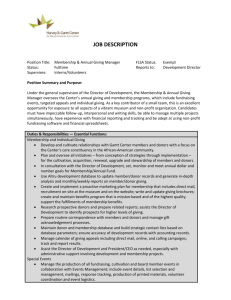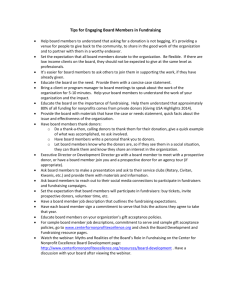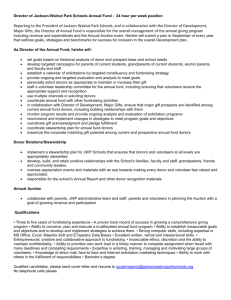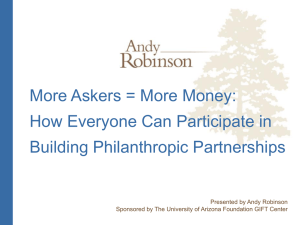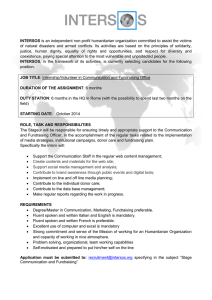Major Individual Donors - Covering Kids & Families
advertisement
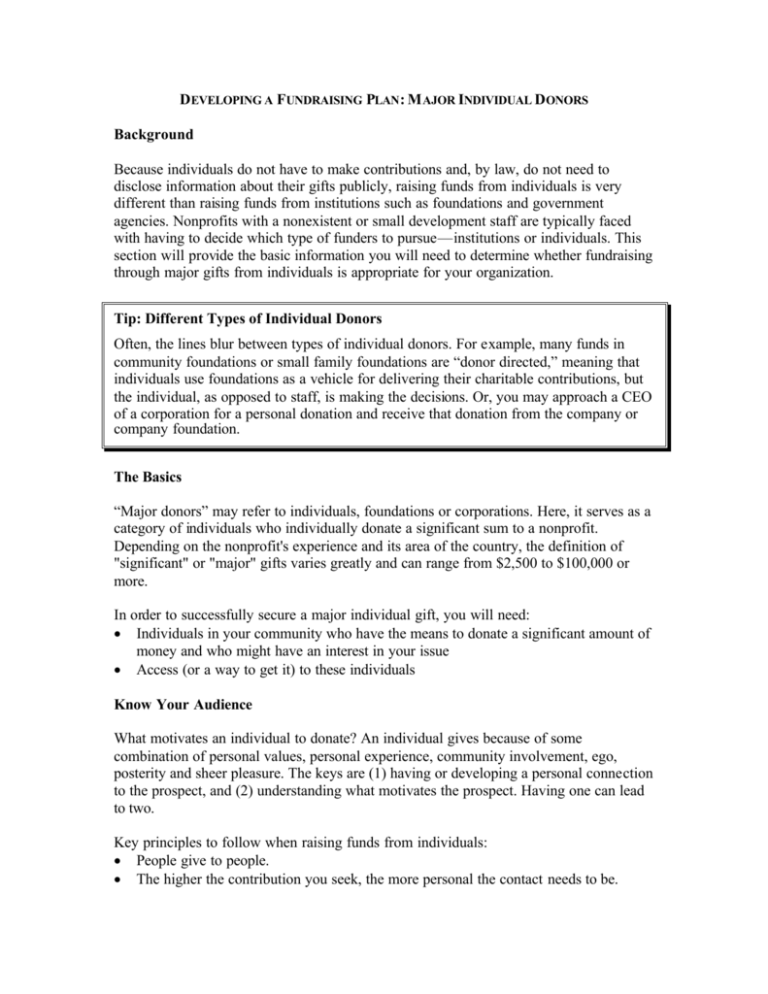
DEVELOPING A FUNDRAISING PLAN : M AJOR INDIVIDUAL DONORS Background Because individuals do not have to make contributions and, by law, do not need to disclose information about their gifts publicly, raising funds from individuals is very different than raising funds from institutions such as foundations and government agencies. Nonprofits with a nonexistent or small development staff are typically faced with having to decide which type of funders to pursue—institutions or individuals. This section will provide the basic information you will need to determine whether fundraising through major gifts from individuals is appropriate for your organization. Tip: Different Types of Individual Donors Often, the lines blur between types of individual donors. For example, many funds in community foundations or small family foundations are “donor directed,” meaning that individuals use foundations as a vehicle for delivering their charitable contributions, but the individual, as opposed to staff, is making the decisions. Or, you may approach a CEO of a corporation for a personal donation and receive that donation from the company or company foundation. The Basics “Major donors” may refer to individuals, foundations or corporations. Here, it serves as a category of individuals who individually donate a significant sum to a nonprofit. Depending on the nonprofit's experience and its area of the country, the definition of "significant" or "major" gifts varies greatly and can range from $2,500 to $100,000 or more. In order to successfully secure a major individual gift, you will need: • Individuals in your community who have the means to donate a significant amount of money and who might have an interest in your issue • Access (or a way to get it) to these individuals Know Your Audience What motivates an individual to donate? An individual gives because of some combination of personal values, personal experience, community involvement, ego, posterity and sheer pleasure. The keys are (1) having or developing a personal connection to the prospect, and (2) understanding what motivates the prospect. Having one can lead to two. Key principles to follow when raising funds from individuals: • People give to people. • The higher the contribution you seek, the more personal the contact needs to be. • • • The larger the contribution sought, the longer the cultivation time. Minimize uneasiness about discussing money by identifying donors with a history of giving. Remember that you are asking for an investment in a program that benefits children, their families and the community as a whole. Major gifts from individuals may offer a better opportunity for CKF grantees than other types of individual fundraising because, in cultivating a prospect, you are able to have a more sophisticated dialogue about the need for your program. Targeting Prospects As with institutional donors, the network of individuals involved with your organization will be critically important in providing names of, background on and access to major donor prospects. Step 1: Compile a prospect list. Begin by compiling a prospect list of: • Major donors to your organization • Individuals who have a direct connection to you or your organization—board of directors, coalition members, corporate partners, donors, employees, personal contacts, volunteers, and vendors and their contacts—who may have the means, or access to someone who has the means, to donate a major gift • Board members and donors to similar organizations • Major philanthropists in the region Step 2: Gather background information so that you can prioritize the names on the list. Collecting background information on individual prospects is much more difficult than it is for institutional prospects. Specifically, you are looking for evidence of: • Links to your organization or to someone in your network • The prospect’s history of donating to causes similar to yours • Their ability to give significant sums (It will be up to you to define “significant.”) • The prospect’s profession, personal interests and the nature of their wealth While development offices of universities and other large nonprofits dedicate significant resources to sophisticated prospect research operations, a small organization should limit the scope of the research to: • Interviewing members of the network • Research in the local newspaper • Searching the Web for information on the prospect and, if applicable, their company The Individual Prospect Worksheet (see Appendix T on p. xxvi) provides a rubric in which to gather the information you find on each prospective donor. M EETING THE M ATCH: M AJOR INDIVIDUAL DONORS Preparing Your Approach Once you have narrowed your prospect list to top targets, the next step is to prepare for and schedule a face-to-face meeting. It is helpful to have the introduction made by someone in your network. If you do not have a direct connection to a potential major donor, first consider ways you can establish one. If you find that even after networking you cannot find a connection, you may want to consider waiting to approach that individual until a connection can be established. When you make the initial call, refer to your mutual acquaintance, give a very brief overview of your project, ask for a meeting and stress that you will take only 30 minutes of their time. Remember, your goal is a face-to-face meeting. When calling remember to: • Make calls when you are in a positive, upbeat mood to ensure that you are conveying enthusiasm and confidence. • Call mid-morning or mid-afternoon, not first thing in the morning or at lunchtime. Securing the meeting means the prospect is willing to entertain your request. The goal of the meeting is to move the prospect from “maybe” to “yes.” The cultivation process may require one meeting or several meetings and conversations before you actually make the ask for a gift. You should be prepared to make the ask in the first meeting. Prepare for the meeting by: • Reviewing prospect research • Asking your contacts for background information on your prospective donor • Rehearsing the ask • Deciding the size of donation to request Making the Ask In the meeting, you will: • Provide compelling information on program and financial needs. o Avoid jargon. o Use quantitative and qualitative information (e.g., the numbers of children and families affected in your region and the impact on families because of your help in enrolling them in SCHIP). • Try to connect your efforts with what you know of the prospect’s values and interests. • Ask for the prospect’s input and listen carefully. • Respond to any concerns they may have. • If the conversation veers off on a tangent, entertain the tangent to a point then bring the conversation back to financial needs. • Be enthusiastic and confident. You will have to use your intuition and judgment about when to make the ask. As soon as you sense that you ha ve their interest and that you have allayed any significant doubts, you should make your request. One thing is certain: do not defer making the ask by offering to send a proposal. Making a direct ask in person is the most effective fundraising method. Keep in mind that they know you are meeting with them to raise money, so they are expecting you to make an ask. In addition, developing a proposal will only unnecessarily add to your already significant workload. After the meeting, immediately send a thank yo u note, being careful to reference any questions they had or any pledge they made. Once the donation is received, send another thank you note. Stewardship Identifying and recruiting a new donor is the most difficult part of the fundraising process. Nurturing the relationship with the donor provides important benefits. By continuing to build upon your relationship with an individual donor, you: • Increase the chances that the donor will provide additional and possibly larger contributions in future years • Expand the network of people you can ask to utilize their personal contacts to assist in your fundraising efforts Do not hesitate to thank them several times and in several ways. For example, you may choose several options from this list: • Personally call and thank the donor. • Send a personal thank you note. • Inform the people who helped you make the connection and encourage them to thank the donor. • Issue a press release with language that is reviewed and approved by the donor. • Include mention of the donor in communication materials (e.g., newsletter, annual report). • Fulfill any acknowledgement offers discussed during the cultivation process. • Offer a small personal gift (e.g., homemade baked goods). Tip: Building a Relationship With Your Donors Try to deepen the funder’s interest in your CKF project by sending updates on your efforts, showing that you are using their money effectively, and inviting them to any appropriate events. For example, if an elected official holds a press conference to promote Medicaid or SCHIP, call your major donors and invite them to attend. DEVELOPING A FUNDRAISING PLAN : O THER INDIVIDUAL FUNDRAISING OPPORTUNITIES Unless you have access to an existing donor base through your organization, you will probably not want to consider the other individual fundraising techniques discussed in this section. If you do have access to a donor base, consult the department that maintains it for additional guidance on implementing these fundraising techniques. Other Techniques for Fundraising From Individuals An endless array of tools exists for soliciting individual contributions other than major gifts. Three of them are: special events, direct mail and telemarketing. These tools are best used for enabling an organization to amass moderate or small contributions from a much larger constituency and may have significant direct costs such as postage and catering in addition to staff time. For Covering Kids & Families grantees, there are three potential disadvantages or challenges to consider: 1. One major challenge that Covering Kids & Families grantees may face with individual fundraising is people’s perception of your funding sources. For organizations that raise the majority of their funds from foundations, corporations and government agencies, there is often a perception that a smaller individual gift will not make a difference or that it is a program that the government or another institution should fund. Therefore, individuals may be reluctant to donate to your CKF project. 2. Because Covering Kids & Families grantees need to raise their matching funds in a relatively short period of time and it can take years to develop a fruitful individual donor base, you will need to carefully assess whether building an individual fundraising program will net enough dollars in time to help you meet your match requirements. 3. Individuals like to feel that their gift is making a difference in a tangible way. For example, the American Red Cross and other relief organizations received unprecedented amounts of contributions in the aftermath of the September 11th terrorist attacks. And the Susan B. Komen Foundation has the ability to mobilize thousands of people whose lives have been touched by breast cancer. While the Covering Kids & Families programs are vitally important to improving the lives of children and families, it may be challenging to appeal to a large number of individuals because of the indirect nature of the initiative. Special Events Special events refer to galas, annual dinners, auctions and any other type of event that is promoted with the express purpose of bringing people together at a certain time and in a certain place to make a contribution. The size of the event, the time and place it’s held, and the price of the tickets may vary greatly. Special events can play an important fundraising role for organizations because they offer an opportunity for their networks to recruit and introduce new donors to the organization at a specific date in time. Special events also offer the opportunity for middle- to lowrange donors to contribute. A successful fundraising event involves: • A fundraising committee, or a network of individuals able and willing to sell tickets to personal and professional networks • Personal, direct solicitation by the committee or, in cases of smaller events, by the host (Do not be seduced by a “great list.” It may generate a 1 percent response to invitations—perhaps 2 percent with follow-up calls—while committee members can receive a 30 to 50 percent response when soliciting personal networks.) • Significant staff time to support the committee’s fundraising efforts and event logistics (Hiring or contracting an experienced event fundraiser should be considered for larger events.) • Direct costs ranging from 15 to 50 percent of gross (not including staff/consultant time) • Time (sometimes several years) for the event to generate a profit or realize its full potential • Lead time of three months to one year to plan and execute the event (depending upon the nature of the event) • Holding the event annually in order to re-solicit donors The major advantages to raising money through events are: • Flexibility on how to use the funds raised • Expansion of your donor base • Expansion of your major donor prospect pool The major disadvantages to relying on events for needed funds are: • They are time and labor intensive • They have significant direct costs up front, so if your fundraising falls short, you can lose money • It can take years for an event to reach its full potential • Typically, you must re-solicit the donors by making the event an annual gathering, since event donors often are not responsive to other types of solicitations, such as mail Grantees should carefully weigh the costs and demands of holding a special event against the net dollars that can be raised. The Events section will provide a brief overview on how to plan an event to raise money toward your match requirement. (Also see the Event Planning Worksheet.) Direct Mail Direct mail refers to mailing a solicitation to a number of people. The letters are not personalized other than including the recipient’s name and address at the beginning of the letter and personalizing the salutation. It can be an informal, in- house effort or a sophisticated effort outsourced to direct- mail specialists. Typically, direct mail solicits small contributions from a large number of people. Some requirements to implementing a successful direct- mail campaign include: • Having a message that is urgent and emotional, since direct mail tends to be a “hot” medium in which these types of pleas are most successful • Access to a large universe of direct- mail responsive donors, often through the renting of a list (The response rate for a successful mailing is 1 to 2 percent, so you would need a large enough universe of prospects in order for 1 to 2 percent to be a sizable enough return. Direct- mail programs typically are suited for larger organizations that have wider audiences because of the size of lists needed for mailing.) • An understanding of direct marketing techniques, including copywriting, graphic design, list rentals, and data analysis (A direct- mail consultant is very helpful.) • Funds to cover the significant upfront costs for list rental, production and postage • Time, since direct- mail programs typically require several years to generate significant profits Telemarketing Telemarketing requires making cold calls, which are what most people envision when they think of fundraising. The needs are similar to those of direct mail: • Having a message that is urgent and emotional, since telemarketing tends to be a “hot” medium in which these types of pleas are most successful • Access to a large enough universe of telemarketing responsive donors (Because of the nature of the lists needed, telemarketing is more suitable for larger organizations (e.g., universities), national or international groups with established constituencies, or issues with broad appeal.) • An understanding of telemarketing techniques, such as scripting and pledge collection (A professional telemarketing firm can be helpful.) • Funds to cover the significant upfront costs for list rental, phone banking and pledge collection • Time, since telemarketing programs typically require at least one to two years to generate significant profits The advantages to raising money from individuals through direct mail or telemarketing are: • Fewer requirements in the ways funds are spent • Fewer, if any, reports needed The major disadvantages to raising money through direct mail or telemarketing are: • It may take years to build a donor base that will generate a significant net income • The results can greatly depend on having staff or consultants with specialized expertise in these areas • The direct costs (e.g., postage) are higher than with grant writing, and the challenges to launching a direct- mail or telemarketing campaign are greater if you do not already have a defined constituency (e.g., church/synagogue members, university alumna) that has a direct connection to the organization and the means to give Federated Fundraising Organizations Federated fundraising organizations are nonprofit organizations that raise and distribute funds for nonprofit member organizations in their community. Federated funds provide financial support to nonprofits in three different ways: 1. Approving an application for membership in the federation, which qualifies it for ongoing annual allocations 2. Providing grants through various discretionary programs, such as community development grants 3. Sponsoring donor option programs, which allow individual employees to make onthe-job gifts during a campaign drive The most common federations are United Ways, religiously affiliated federations and alternative funds: • United Ways are organizations that raise and distribute funds for a variety of social service agencies on the local level. Additionally, United Ways may undertake other activities that aid the well-being of their nonprofit member agencies and their own communities, such as management assistance programs, long-term planning, and information and referral services. Most local United Ways are members of their parent organization, the United Way of America. By and large, they receive the bulk of their support from company employees who have been solicited at the workplace, and from major companies through grants. • Religiously affiliated federations are generally established to raise money from individuals in the faith-based community to provide financial support to organizations that represent the giving interests of a particular religious faith. Examples include local Catholic charities and Jewish federations. • Alternative funds are public charities established to raise and distribute funds to organizations that share a particular constituency or set of common concerns. Examples include the United Arts Funds and Combined Health Agency funds. The advantages of securing support from a federated fund include: • Reliable source of steady income. If you are fortunate enough to be approved for membership in a federated fund, you are generally assured of its ongoing support as long as you remain a member in good standing. • Savings in your own fundraising time and budget. Federated funds are generally more efficient because they centralize all of the fundraising staff time and budget outlays. • Heightened public profile. Federated fund campaigns usually promote the work of their member agencies throughout the community, so your organization would receive publicity as a member of the fund. Member agencies are also sometimes invited to present to groups of prospective donors on the merits of giving to their organization. • Enhanced reputation. Through your association with a federated effort, you usually can receive a boost in your reputation. Well-organized federations have ties to their communities and those contacts can be a value to your work. • Networking and technical assistance. Through participation in a federated campaign, you will have the opportunity to meet others in the same line of work. You may also have access to training materials and sessions organized by the federation. The disadva ntages of securing funds from a federated fund are: • Restrictions on your own fundraising. Admittance to a large federation usually involves restriction on other types of fundraising in which an organization can participate. The federation will usually reserve the right to decide if a fundraising practice is acceptable or not based on how it affects the interests of the federation. • Long waiting period for admission (or rejection). Because of the bureaucracy that can sometimes be in place at a large organization, it can take upwards of a year to have your application for membership approved and to begin receiving funds. • Fluctuating levels of support. As long as you are fulfilling your mission as stated to the federation, your membership should remain intact. However, the amount of money that is allocated to your organization from the fund can fluctuate depending on a variety of factors, but especially if the total amount of monies collected by the federation changes. • Contribution of time and labor to actual fundraising campaigns. Participation in federated campaigns requires a significant amount of staff time during the funding drives. The federations will usually request organizations to participate in information fairs and presentations to potential donors at their workplace. You may also have to compete with representatives from other nonprofits. This can sometimes be frustrating because, while the work you do for Covering Kids & Families is vital to the community, it may not be as tangible to donors as other giving opportunities, such as an animal shelter or soup kitchen. • Subtle pressure toward conformity. Membership in a federation can sometimes sway the projects of a particular organization if the federation announces that it is interested in funding a particular type of work. While a federation cannot outwardly tell an organization what to do, some members may change their focus in the hopes of increasing their fund allocation.
